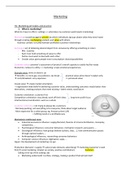Marketing
H1: Marketing principles and practice
1. What is marketing?
What do I have to offer (= selling) <-> what does my customer want/need (=marketing)
Marketing= social/managerial process by which individiuals /groups obtain what they need +want
through creating /exchanging products and value with others.
Business context: to build/maintain profitable customer relationships
Exchange = act of obtaining desired object from someone by offering something in return
- Min. 2 parties
- Each must hold something of value to offer
- Parties must want to deal with each other
• Creates value, gives people more consumption choices/possibilities
Customer value: customer’s assessment of product’s overall capacity to satisfy his/her needs
Economics: reduce to utility <-> marketing: create emotional experiences
Example value: drive an electric car
à Benefits: no more gas, less pollution, tax break … practical value alone doesn’t explain why
à costs/drawback: very expensive => perceived value
Create value à create market orientation
= organization-wide belief in delivering customer value, understanding costumers needs better than
themselves, creating products that meet existing + latent needs, now/future
Customer orientation: customer first
Competition orientation: stay ahead, work off their ideas long-term profit focus
Interfunctional coordination: work as a whole
Customer centricity = not trying to please ALL customers
- Not keep pushing, not everything is for everyone, think about target audience
- More expensive for a select group, eg. Amazon prime (1/4)
= fulfilling needs in a profitable way
Marketing’s intellectual roots
• Industrial economics influence: supply/demand, theories of income distribution, monopoly,
competition, …
• Psychological influences: consumer behaviour, motivation research, persuasion, …
• Sociological influences: how groups behave (culture, class, …), how communication passes
through opinion leaders, …
• Anthropological influences, researching consumer behaviour
• Computer science influences: digitization, apps, …
Figure: the development of marketing: zie ppi
Production (demand > supply) à sales (create demand, advertising) à marketing (customer’s need
first)à social marketing (impact on society, positive contribution). Evolution
Selling is the tip of the iceberg: ads
• Marketing underneath t surface, strategy, making a product that will sell itself
,Eg.: Benettton vs zara = advertising vs strategy
Figure: difference marketing and sales
1.2 Marketing: application and relevance
Physical products, services, retail (media markt, zara), experiences (pairi daiza, de zoo), events
(Tomorrowland), film, music, theater, places (work, study, vacation), ideas, charities and non-profits,
people
• Anywhere people, buyers, have a choice, anywhere marketing applies
1.3 The marketing process
Figure: a functional map for marketing
o Core + technical + behaviour, a lot of different
competences
Stakeholders: eg. school: parents, the government (financial support), neighbours (noise), companies
(recommendation) …
= anyone who has an impact/interest in the organization
o Evolve to co-creation: work with the stakeholders
Value of the costumers: eg. students: give good recommendations, share experiences, feedback,
loyalty
Figure: simple marketing exchange process
,Figure: marketing in context
• consumer goods
Marketing process
Understand marketplace/customer needs
è design customer-driven marketing strategy
è construct/integrated marketing programme create value/build relationships
è build profitable relationships/ create customer delight
è capture value from customers to create profits and customer equity => receive value from
customers in return
1) Understand marketplace/customer needs
Figure: Maslow’s pyramid of needs
Needs are key:
• solution to a need, rather than focusing on just product
• Underlying needs > wants
• Look beyond attributes => create brand meaning/experiences
Eg. ING: all banks are the same, but ING, sponsor of music festivals (contact info to get into free
locker system), football
2) Market strategy
Strategy: STP
• selecting a target market: market é -> target marketing
• value proposition: “Why by our brand instead of competition?”
differentiation, eg. redbull: because it gives you wings, connotation volvo and safety
, Figure: the triple value proposition
Eg. Patagonia: high quality clothing and good for the environment, donating black Friday profit to
grassroots environmental groups
3) Marketing programme
translate strategy into marketing mix
• 4 P’s: promotion, place, product, price
• 4 C’s: communication, customer, cost, convenience
New P: personalization, eg. name on starbucks cups
• Making millions feel like one in a million
4) Build relationships and create customer delight
Figure: marketing automation
Customer relationship management = CRM
= the process of acquiring detailed information of individual customers and carefully building and
managing customer relationships by delivering superior value.
Touching points: moment of purchase, surveys, payments, website visits …
Figure: marketing automation vs CRM
Turning leads (possible interested people) into clients
Selective relationship management
Customer lifetime value = prediction of all the value a business will derive from their entire
relationship with a customer
• maximizing profit over customer’s lifetime




